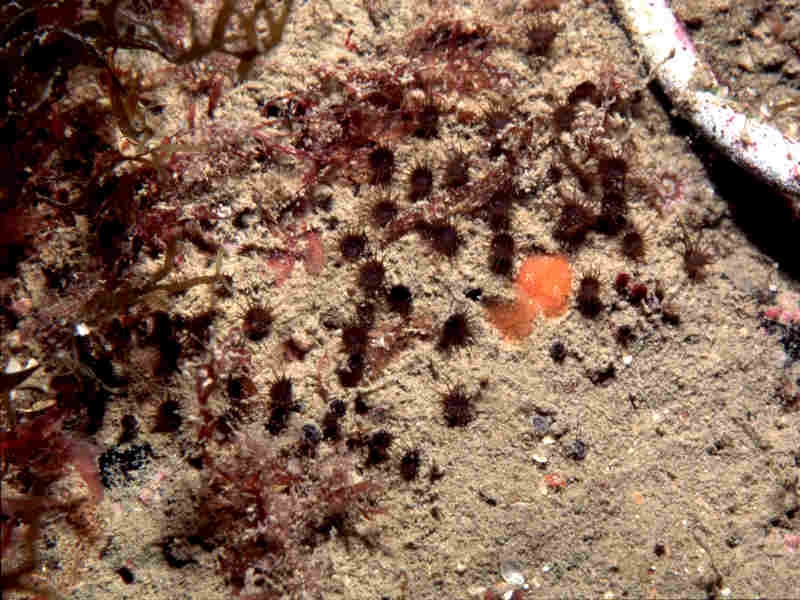Ginger or chocolate tiny anemone (Isozoanthus sulcatus)
Distribution data supplied by the Ocean Biodiversity Information System (OBIS). To interrogate UK data visit the NBN Atlas.Map Help
| Researched by | Sonia Rowley | Refereed by | Admin |
| Authority | Gosse, 1859 | ||
| Other common names | - | Synonyms | Isozoanthus danicus |
Summary
Description
Recorded distribution in Britain and Ireland
Isozoanthus sulcatus has been recorded mainly on the western coasts of Britain and Ireland. Due to its cryptic nature this species maybe under recorded.Global distribution
-Habitat
Isozoanthus sulcatus can be found on exposed vertical open and silty rocks, stones and shells in the intertidal and shallow sublittoral down to 42 m depth and in rock pools.Depth range
-Identifying features
- Tiny polyps arising in small clusters from coenenchyme.
- Fine sand and debris encrusting coenenchyme and lower polyp walls.
- Polyps up to 1 cm high, 0.
- 3 cm diameter.
- 16-30 short blunt tentacles arranged in 2 cycles.
- Primary tentacles associated with corresponding marginal tooth.
- Polyps olive-chocolate brown in colour.
- Brown saucer-shaped disc.
Additional information
Isozoanthus sulcatus is also more commonly known as 'ginger tinies', 'chocolate' or 'peppercorn' anemone. This species is the only known European zoanthid to possess endodermal zooxanthellae, which under a microscope appear as spherical brown cells. When in adverse conditions, such as excessive temperature increase (Williams, 2000), these zooxanthellae may be expelled. Isozoanthus sulcatus is a very sensitive species retracting its tentacles at the slightest disturbance, this coupled with its sublittoral presence and cryptic nature means that it is probably overlooked, therefore under recorded. This species remains contracted in the dark and opens usually within 5 minutes of exposure to light, which is probably an adaptive behaviour related to the possession of zooxanthellae (Williams, 2000).The number of marginal tentacles in this species is equal to and opposite each of the primary (inner) tentacles (Williams, 2000), which updates the description given by Manuel (1981). The secondary (outer) tentacles can actually slope downwards alongside the column due to the lack of adjacent marginal teeth. This species is gonochoristic, and asexual reproduction occurs via budding arising from the existing polyp walls or the basal coenenchyme
Listed by
- none -
Bibliography
Gibson, R., Hextall, B. & Rogers, A., 2001. Photographic guide to the sea and seashore life of Britain and north-west Europe. Oxford: Oxford University Press.
Hayward, P., Nelson-Smith, T. & Shields, C. 1996. Collins pocket guide. Sea shore of Britain and northern Europe. London: HarperCollins.
Hayward, P.J. & Ryland, J.S. (ed.) 1995b. Handbook of the marine fauna of North-West Europe. Oxford: Oxford University Press.
Howson, C.M. & Picton, B.E., 1997. The species directory of the marine fauna and flora of the British Isles and surrounding seas. Belfast: Ulster Museum. [Ulster Museum publication, no. 276.]
Manuel, R.L., 1981. British Anthozoa. London: Academic Press.[Synopses of the British Fauna, no. 18.]
Williams, R.B., 2000. A redescription of the zoanthid Isozoanthus sulcatus (Gosse, 1859), with notes on its nomenclature, systematics, behaviour, habitat and geographical distribution. Ophelia, 52, 193-206.
Wood, E. (ed.), 1988. Sea Life of Britain and Ireland. Marine Conservation Society. IMMEL Publishing, London
Wood. C., 2005. Seasearch guide to sea anemones and corals of Britain and Ireland. Ross-on-Wye: Marine Conservation Society.
Datasets
Isle of Wight Local Records Centre, 2017. IOW Natural History & Archaeological Society Marine Invertebrate Records 1853- 2011. Occurrence dataset: https://doi.org/10.15468/d9amhg accessed via GBIF.org on 2018-09-27.
Manx Biological Recording Partnership, 2022. Isle of Man historical wildlife records 1990 to 1994. Occurrence dataset:https://doi.org/10.15468/aru16v accessed via GBIF.org on 2024-09-27.
NBN (National Biodiversity Network) Atlas. Available from: https://www.nbnatlas.org.
OBIS (Ocean Biodiversity Information System), 2025. Global map of species distribution using gridded data. Available from: Ocean Biogeographic Information System. www.iobis.org. Accessed: 2025-05-02
Citation
This review can be cited as:
Last Updated: 26/06/2007



